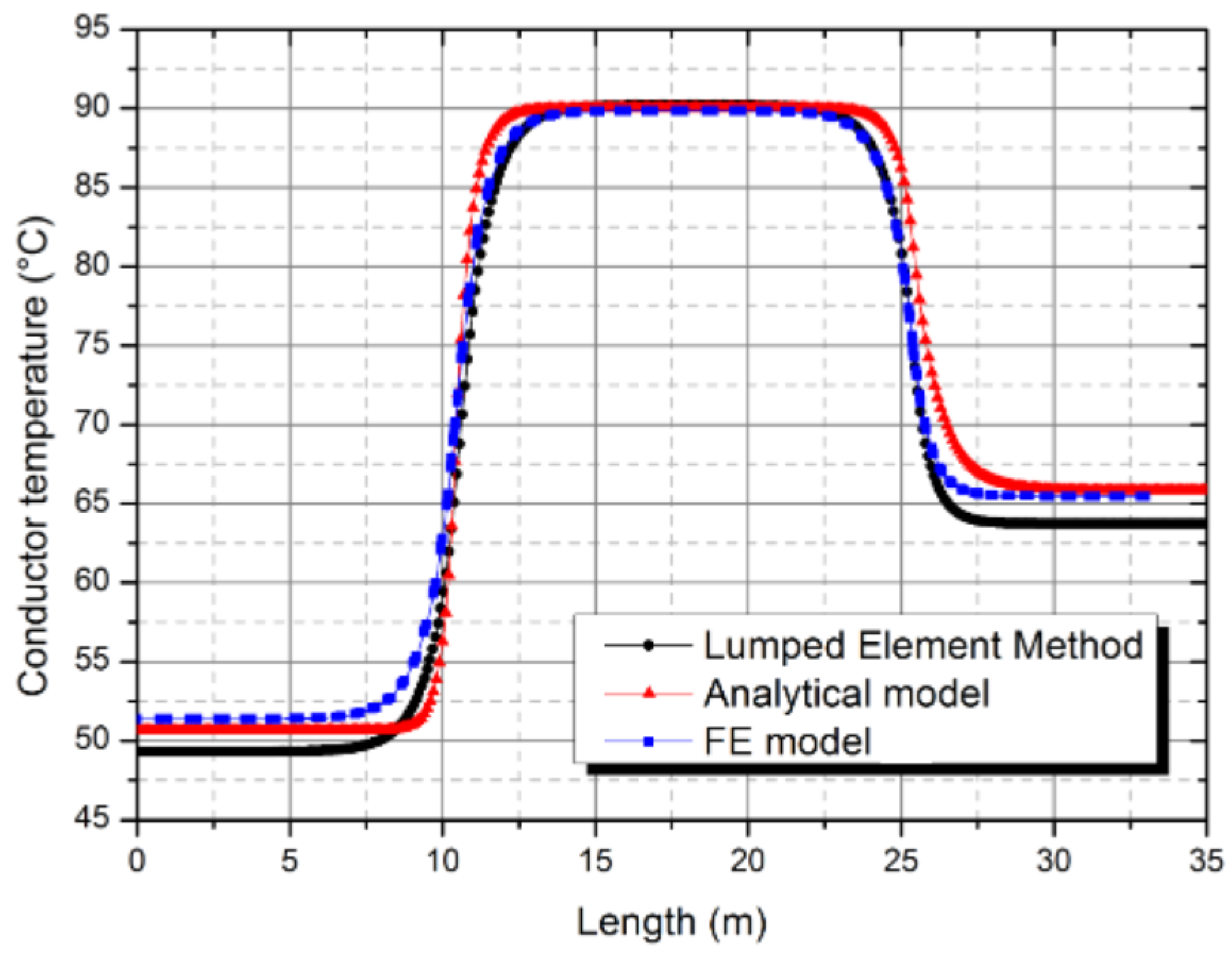A Model for the Thermal Behaviour of an Offshore Cable Installed in a J-Tube †
Abstract
:1. Introduction
2. Configuration
3. Numerical Model
3.1. Explanations
- the net heat inflows into the elemental volume
- , the volume density of energy generated and dissipated in the elemental volume .
3.2. Application
3.2.1. Discretization
3.2.2. Calculations
3.2.3. Comparison with Previous Work
4. Sensibility Analysis
4.1. Definition of Study Parameters
4.2. Simple Parametric Study: “One-at-a-Time”
- An increase in the gap between the cable and the tube would improve the ampacity of the cable. It is clear that increasing the gap would improve exchanges by natural convection in particular.
- The conductor’s temperature is minimal when the emissivities of the surfaces are maximal. However, it should be noted that lower surface emissivity also leads to much higher temperatures. It would therefore be important to precisely characterize these emissivities.
- The influence of the Sun is extremely important here, and modifying the outer surface of the tube to allow it to reflect the Sun’s rays as much as possible would considerably increase the ampacity of the cable.
- Better exchanges by convection inside the tube would undeniably allow better cooling of the cable. Here we have limited ourselves to natural convection (, but it is obvious that allowing forced convection, by creating air circulation for example, would greatly improve the ampacity of the cable [9].
- Additionally, it would be interesting to know how important the improvement of the cable temperature could be if we had the ideal configuration, as . For this configuration, we obtain a core temperature of , which is an improvement of compare to the temperature obtained with the configuration described in [8]. It is important to note that is the most influential here: for the configuration , we obtain a core temperature of i.e., a improvement.
4.3. Sobol Indices
4.3.1. Explanation
4.3.2. Estimation of Sobol Indices by Monte Carlo Method
4.3.3. Uncertainty Assessment by Boostrap Method
4.3.4. Application
5. Discussion
6. Conclusions
Nomenclature
| Letters | |||||
| Surface heat flux | Matrix of radial thermal conductances | ||||
| Thermal conductivity | Matrix of convection conductances between the cable and the tube | ||||
| Diameter | Matrix of conductances between outer tube surface and ambient | ||||
| Temperature | K | Matrix of axial thermal conductances | |||
| Radiative emissivity | Vector of axial nodes temperature | ||||
| Stefan constant | Vector of gas temperature | ||||
| Lineic surface | Vector of heat sources | ||||
| Heat exchange coefficient | Wind velocity | ||||
| Rayleigh number | Shape coefficient | ||||
| Sun heat flux | |||||
| Section length | Outer tube surface absorptivity of Sun heat flux | ||||
| Gap | Gap between cable and inner tube surface | Electricity losses in core, dielectric, screen, armour | W | ||
| Radius | |||||
| Heat flux | |||||
| Subscripts | |||||
| Cable surface | / | Outer tube surface | / | ||
| Inner tube surface | / | Temperature mean | / | ||
| Ambient | / | ||||
References
- IEC. Electric Cables—Calculation of the Current Rating—Part 1-1: Current Rating Equations (100% Load Factor) and Calculation of Losses—General; IEC: Geneva, Switzerland, 2014. [Google Scholar]
- IEC. Electric Cables—Calculation of the Current Rating—Part 2-1: Thermal Resistance—Calculation of Thermal Resistance; IEC: Geneva, Switzerland, 2015. [Google Scholar]
- Coates, M.; Coates, M. Rating Cables in J-Tube; Report No. 88-0108; ERA technology: Leatherland, UK, 1988. [Google Scholar]
- Hartlein, R.A.; Black, W.Z. Ampacity of electric power cables in vertical protective risers. IEEE Trans. Power Appar. Syst. 1983, PAS-102, 1678–1686. [Google Scholar] [CrossRef]
- Anders, G.J. Rating of cables on riser poles. In Jicable; Paris-Versailles: Paris, France, 1995; pp. 602–607. [Google Scholar]
- Anders, G.J. Rating of cables on riser poles, in trays, in tunnels and shafts. IEEE Trans. Power Deliv. 1996, 11, 3–11. [Google Scholar] [CrossRef]
- Chippendale, R.; Cangy, P.; Pilgrim, J. Thermal Rating of J tubes using Finite Element Analysis Techniques. Jicable 2015, 2015, 4–9. [Google Scholar]
- Chippendale, R.D.; Pilgrim, J.A.; Goddard, K.F.; Cangy, P. Analytical thermal rating method for cables installed in J-Tubes. IEEE Trans. Power Deliv. 2017, 32, 1721–1729. [Google Scholar] [CrossRef]
- You, L.; Wang, J.; Liu, G.; Ma, H.; Zheng, M. Thermal Rating of Offshore Wind Farm Cables Installed in Ventilated J-Tubes. Energies 2018, 11, 545. [Google Scholar] [CrossRef]
- Arancio, J.A.; Ould El Moctar, M.; Nguyen-tuan, M.; Roques, J.P.; Tayat, F. Thermal rating of submarine cables installed in J-tube using Lumped Element Method. In Proceedings of the Jicable19, Paris-Versailles, France, 23–27 June 2019; pp. 2–6. [Google Scholar]
- CIGRE. Calcul de la température des câbles dans les tunnels ventilés. Electra 1992, 143, 38–59.
- Pilgrim, J.A.; Swaffield, D.J.; Lewin, P.L.; Larsen, S.T.; Waite, F.; Payne, D. Rating independent cable circuits in forced-ventilated cable tunnels. IEEE Trans. Power Deliv. 2010, 25, 2046–2053. [Google Scholar] [CrossRef]
- Hamby, D.M. A Review of Techniques for Parameter Sensitivity. Environ. Monit. Assess. 1994, 32, 135–154. [Google Scholar] [CrossRef] [PubMed]
- Sobol, I.M. Global sensitivity indices for nonlinear mathematical models and their Monte Carlo estimates. Math. Comput. Simul. 2001, 55, 271–280. [Google Scholar] [CrossRef]
- Jacques, J. Pratique de l’analyse de sensibilité : Comment évaluer l’impact des entrées aléatoires sur la sortie d’un modèle mathématique. Lille sn 2011, 71, 266–276. [Google Scholar]
- Iooss, B. Review of global sensitivity analysis of numerical models. J. De La Société Française De Stat. 2011, 151, 3–25. [Google Scholar]
- Dorison, E.; Protat, F. Current rating of cables installed in tunnels. Jicable 2007, 2007, 19–23. [Google Scholar]
- Keyhani, M.; Kulacki, F.A.; Christensen, R.N. Free Convection in a Vertical Annulus with Constant Heat Flux on the Inner Wall. J. Heat Transf. 1983, 105, 454–459. [Google Scholar] [CrossRef]
- Saltelli, A.; Homma, T. Importance measures in global sensitivity analysis of model output. Reliab. Eng. Syst. Saf. 1996, 52, 1–17. [Google Scholar]
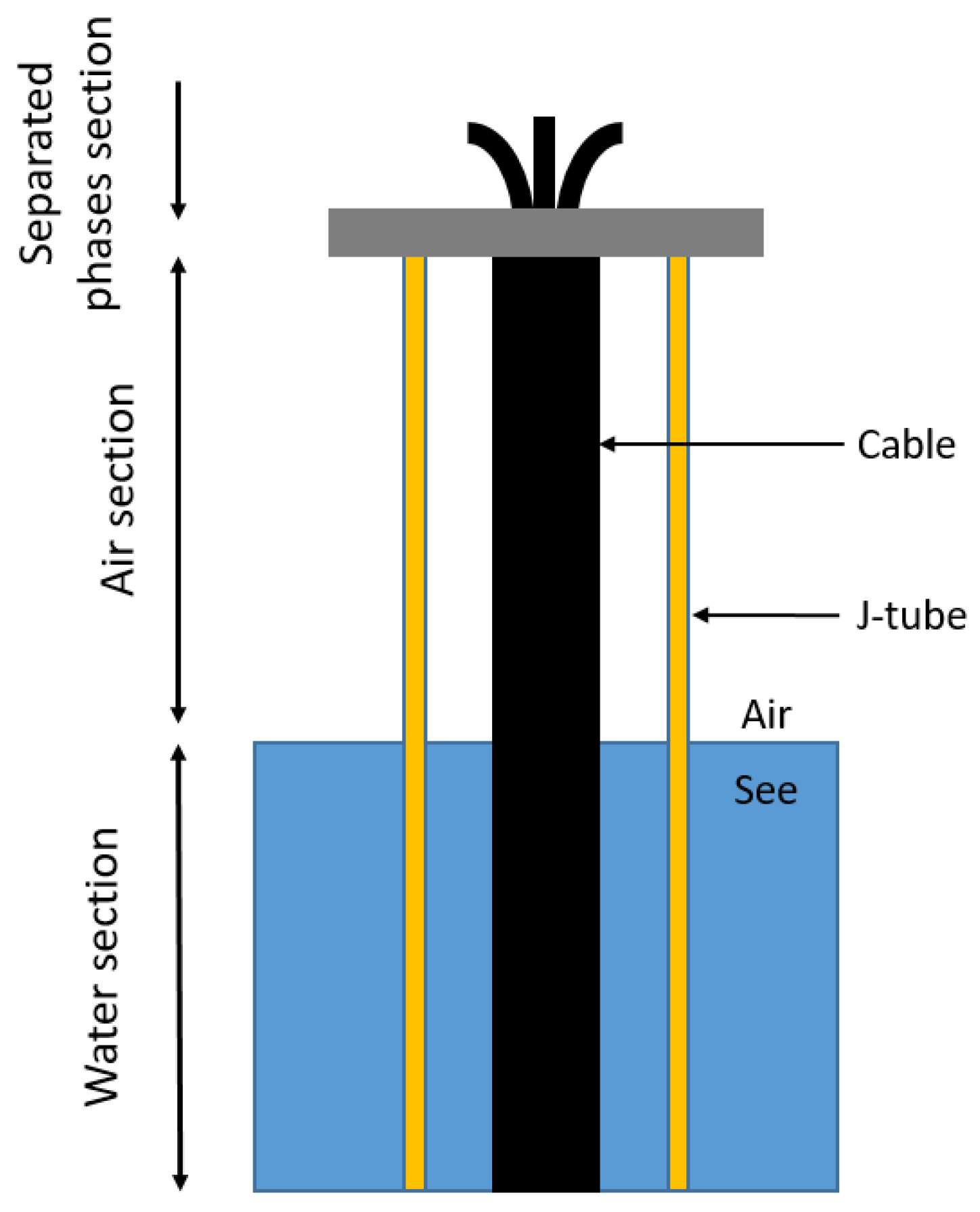
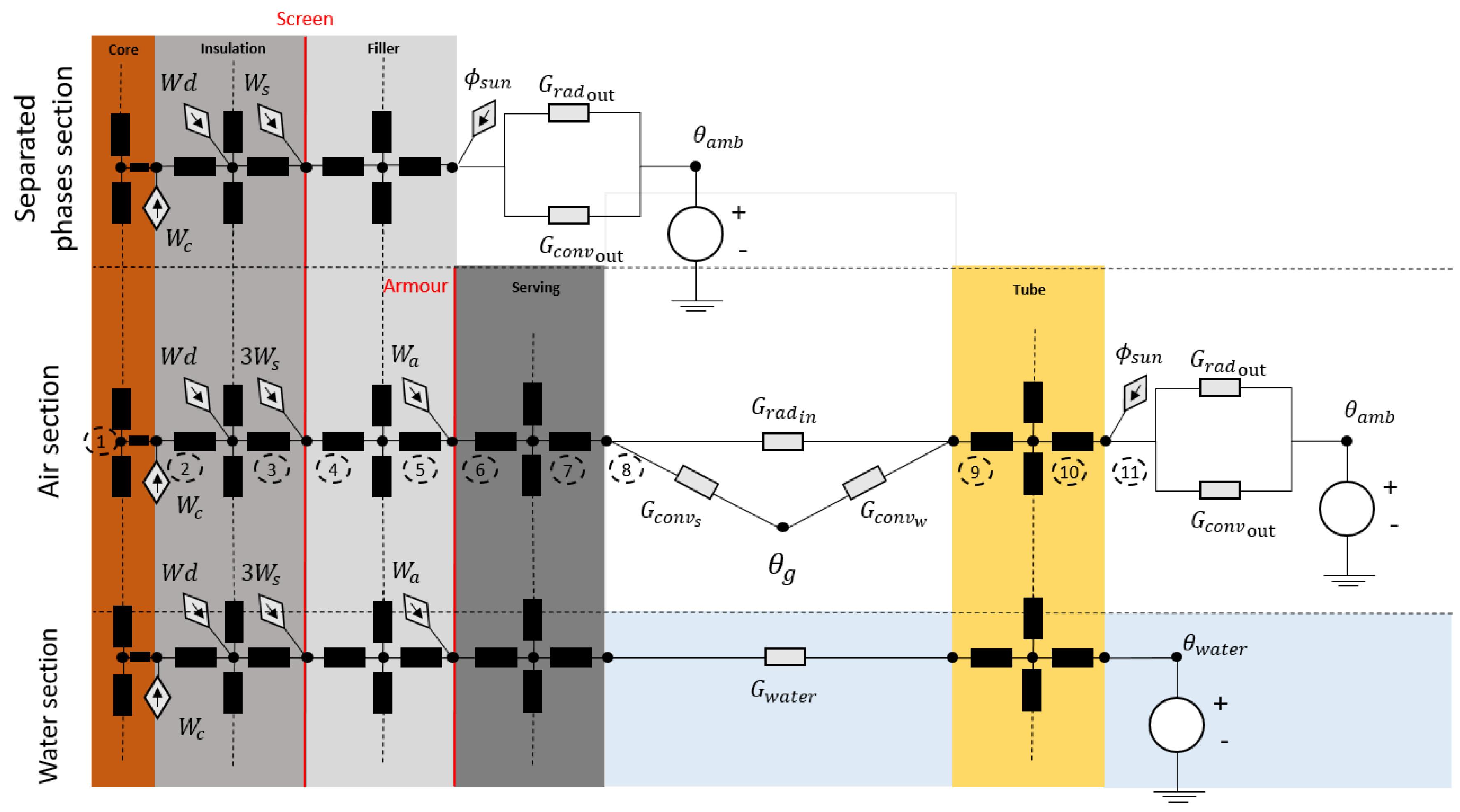
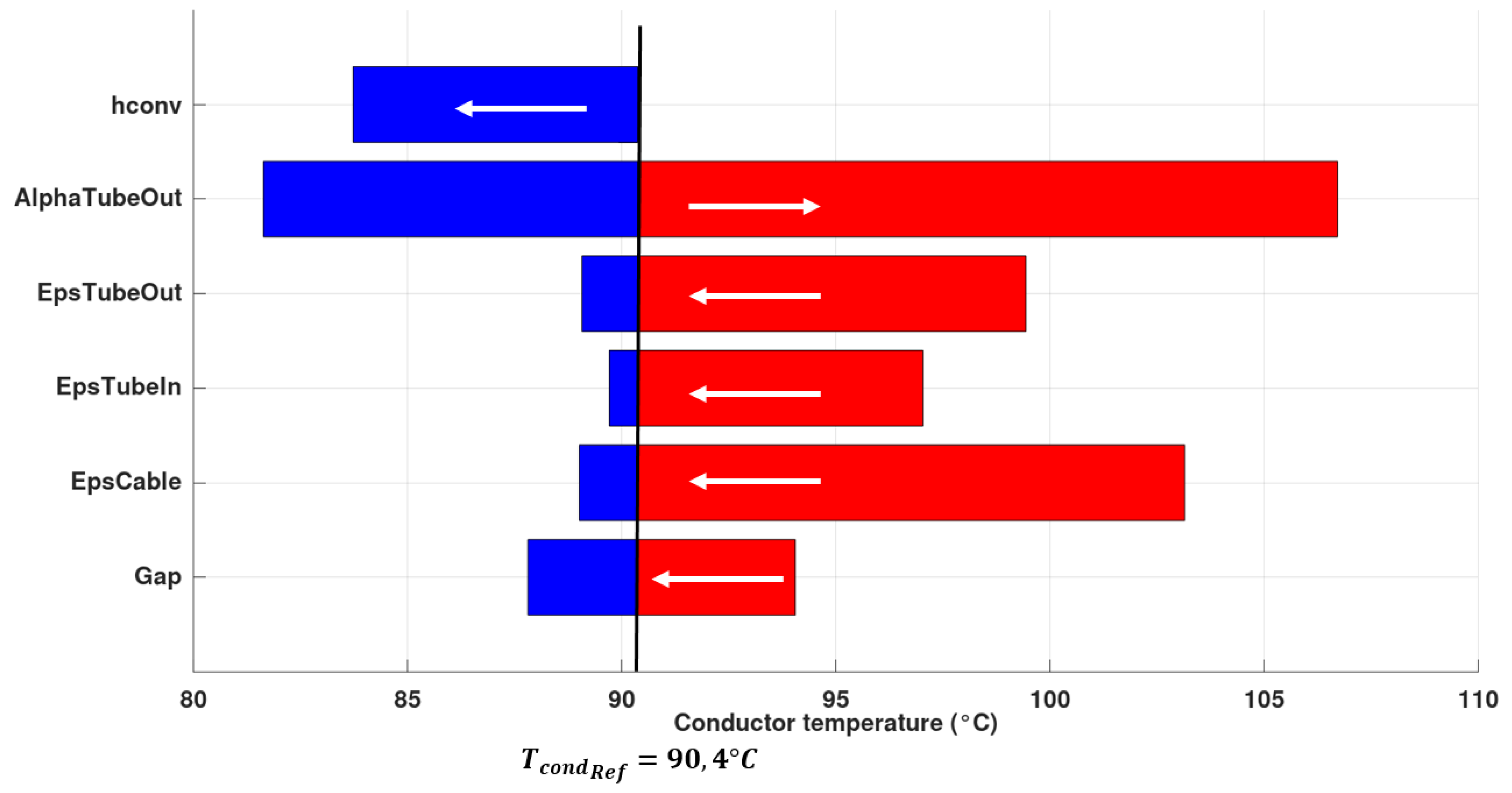
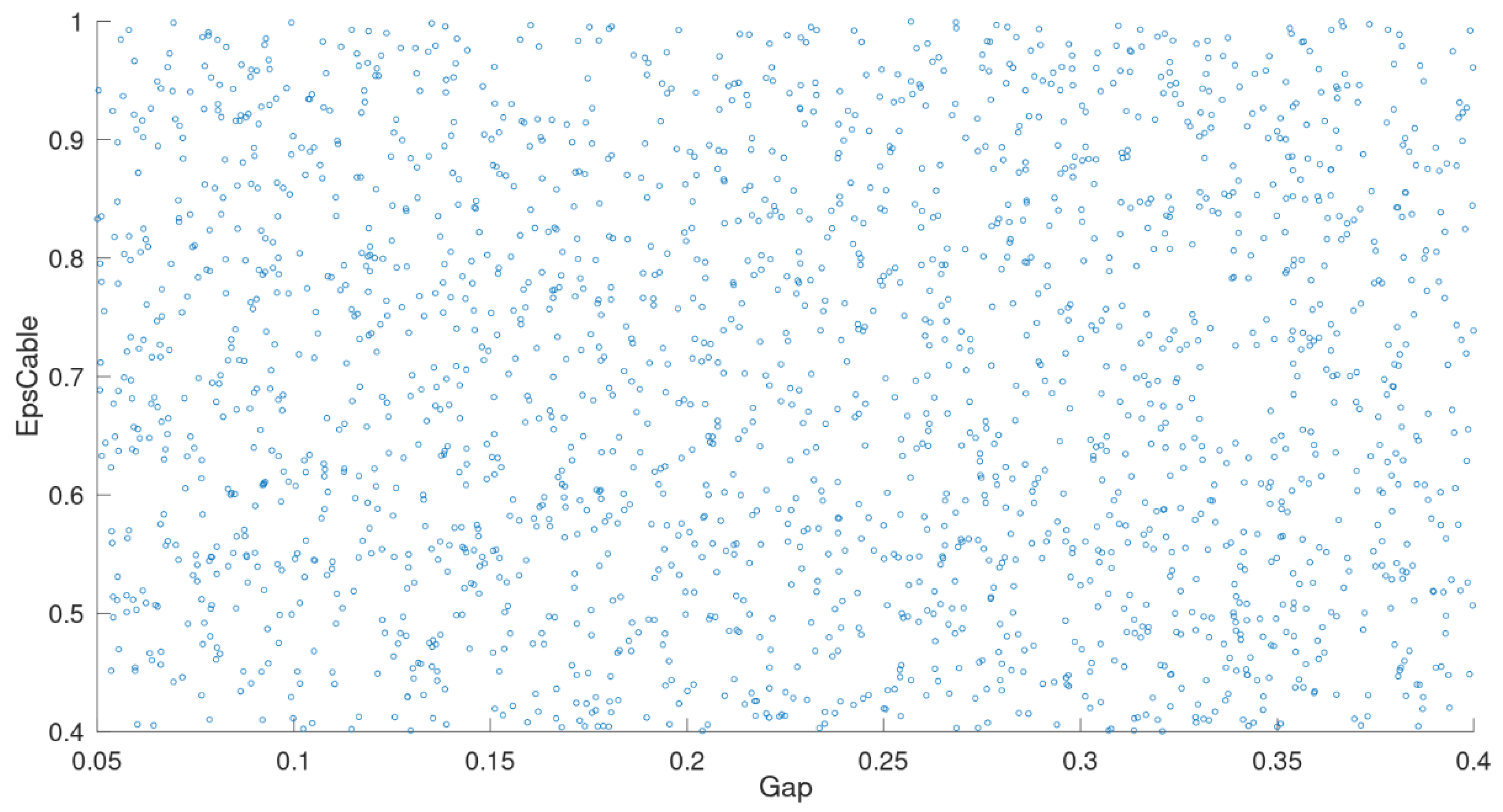
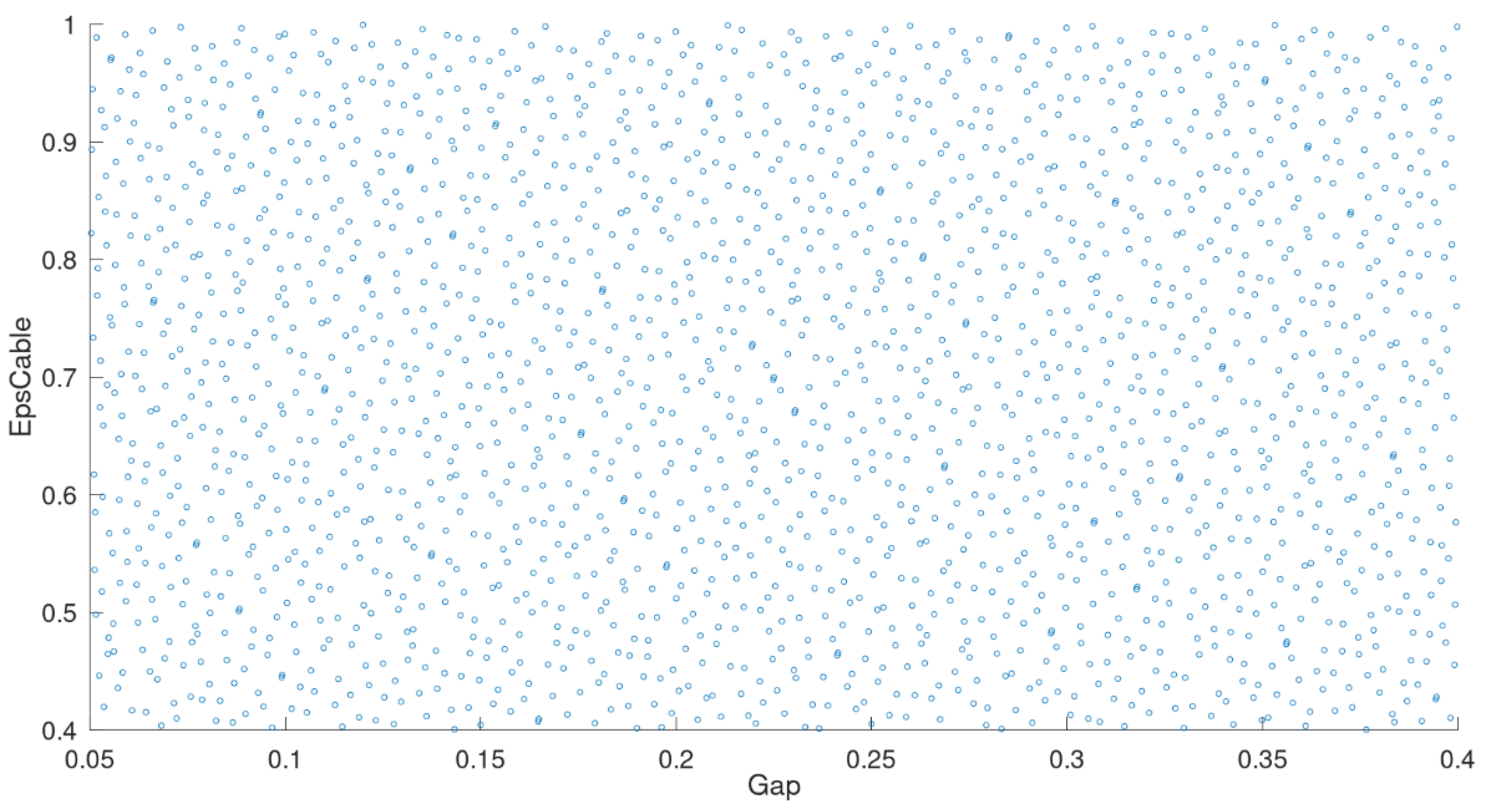
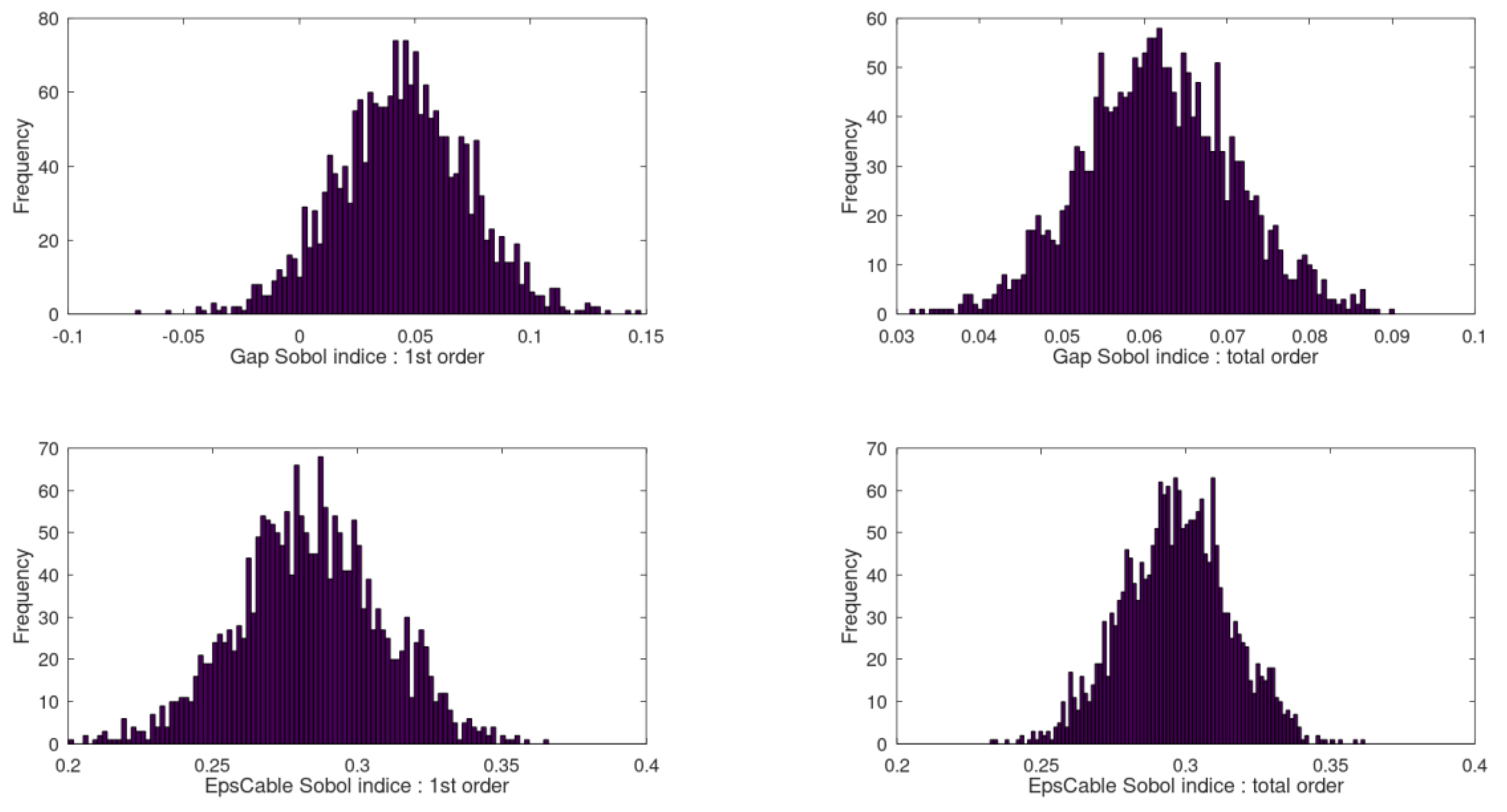
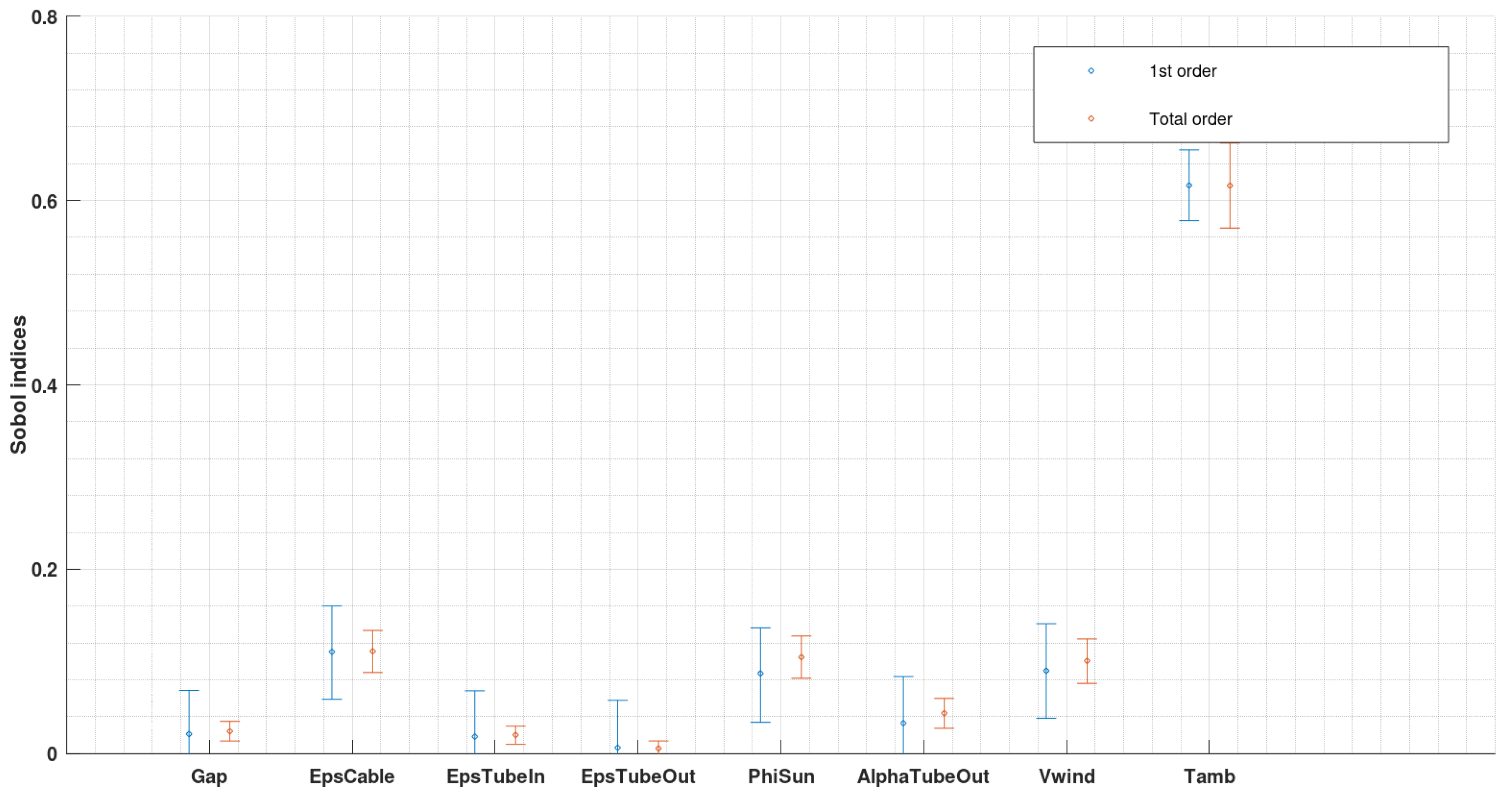

| Parameters | Min | Max | Unity |
|---|---|---|---|
| Gap | 0.05 | 0.40 | m |
| 0.4 | 1 | / | |
| 0.4 | 1 | / | |
| 0.4 | 1 | / | |
| ) | 0.2 | 0.8 | / |
| 2 | 10 | ||
| 0 | 1000 | ||
| 10 | 50 | ||
| 0 | 10 |
| Sobol Indices | ||||
| Parameters | 1st order | Total order | 1st order | Total order |
| Gap | 0.021 (0, 0.069) | 0.024 (0.014, 0.035) | 0.045 (0, 0.10) | 0.062 (0.044, 0.080) |
| 0.11 (0.059, 0.16) | 0.11 (0.088, 0.13) | 0.28 (0.23, 0.33) | 0.30 (0.26, 0.33) | |
| 0.019 (0, 0.068) | 0.020 (0.010, 0.030) | 0.034 (0, 0.089) | 0.050 (0.034, 0.065) | |
| 0.006 (0, 0.058) | 0.006 (0, 0.014) | 0.003 (0, 0.057) | 0.014 (0, 0.030) | |
| 0.087 (0.034, 0.14) | 0.10 (0.082, 0.13) | 0.22 (0.16, 0.27) | 0.27 (0.23, 0.32) | |
| 0.033 (0, 0.083) | 0.044 (0.028, 0.060) | 0.074 (0.020, 0.12) | 0.11 (0.084, 0.14) | |
| 0.090 (0.038, 0.14) | 0.10 (0.076., 0.12) | 0.22 (0.17, 0.27) | 0.27 (0.22, 0.30) | |
| 0.62 (0.58, 0.65) | 0.62 (0.57, 0.66) | / | / | |
Publisher’s Note: MDPI stays neutral with regard to jurisdictional claims in published maps and institutional affiliations. |
© 2020 by the authors. Licensee MDPI, Basel, Switzerland. This article is an open access article distributed under the terms and conditions of the Creative Commons Attribution (CC BY) license (https://creativecommons.org/licenses/by/4.0/).
Share and Cite
Arancio, J.; Moctar, A.O.E.; Tuan, M.N.; Tayat, F.; Roques, J.-P. A Model for the Thermal Behaviour of an Offshore Cable Installed in a J-Tube. Proceedings 2020, 58, 31. https://doi.org/10.3390/WEF-06936
Arancio J, Moctar AOE, Tuan MN, Tayat F, Roques J-P. A Model for the Thermal Behaviour of an Offshore Cable Installed in a J-Tube. Proceedings. 2020; 58(1):31. https://doi.org/10.3390/WEF-06936
Chicago/Turabian StyleArancio, Jeremy, Ahmed Ould El Moctar, Minh Nguyen Tuan, Faradj Tayat, and Jean-Philippe Roques. 2020. "A Model for the Thermal Behaviour of an Offshore Cable Installed in a J-Tube" Proceedings 58, no. 1: 31. https://doi.org/10.3390/WEF-06936
APA StyleArancio, J., Moctar, A. O. E., Tuan, M. N., Tayat, F., & Roques, J.-P. (2020). A Model for the Thermal Behaviour of an Offshore Cable Installed in a J-Tube. Proceedings, 58(1), 31. https://doi.org/10.3390/WEF-06936



